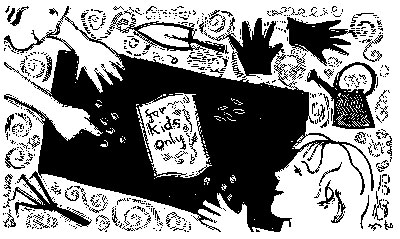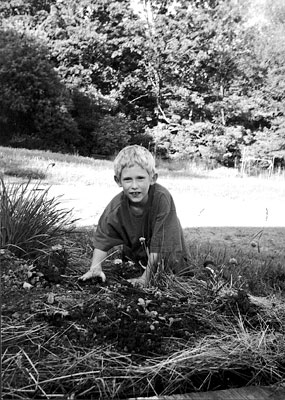 |
| Toki Oshima illustration |
Half a Dozen Books With Garden Themes
By Sue Smith-Heavenrich
A few summers ago the local weekly was promoting a garden contest to keep kids “off the streets and doing something worthwhile.” I wasn’t interested in encouraging my children to grow giant zucchinis, but I was interested in the free seeds. They came in large jumble packets from Gurney’s, with big letters that said: for kids only. While I love to garden, my children would prefer to do other things. Building forts, marching around the driveway on sentry duty, or using the compost bucket as an archery target rate much higher than pulling weeds on their list of “things to do this summer.” I hoped that seed packets labeled for kids only would catch their interest. I left the seed packets on the kitchen table. Eventually the kids found them. They, of course, wanted to open them immediately to see what was inside. “No way,” I said. “Not until you have a place to plant them.” Two or three days later we had a nice spot tilled up. Just needed a bit of raking, a few rocks removed … So with hoe and rakes the three of us created some beds for the jumble gardens. Then we opened the seed packets. Guerney’s calls them jumble packets for a reason: About a tablespoon of seeds, all of different kinds, is put into one packet. We poured the seeds onto a flat tray. “Oh, look! Two kinds of corn!” “Are these peas?” “This looks like the funniest bean I ever saw.” I helped the children sort the seeds according to size, explaining that large seeds need to be planted deeper and require more space than the small seeds.
My reluctant gardeners were transformed. On their knees, they contemplated their 3’ x 6’ bed much as a painter contemplates blank canvas. Where should the peas go? Wouldn’t a bunch of flowers look good here, among the beans? And what about design … should they be planted in straight lines or in clusters? After a brief time-out to determine optimum seed spacing, they began sowing their designs. And dreams. “So, when will my peas be ready to eat?” “Peas take awhile,” I said. “About 10 weeks in a good spring. Nearly forever if the woodchucks get ‘em.” “So, when can we eat them?” I took the kitchen calendar down from the wall, and we counted the weeks. “June 20th,” groaned Toby, “I’ll starve!” As a homeschooling mom, I tend to see opportunities for learning in almost every aspect of our daily lives. Our summer gardens are no exception, and this particular summer offered an abundant harvest of educational riches. In addition to learning how to weed, my children discovered they loved peas and spinach, and even tried greens with such strange-sounding names as “tatsoi” and “orach.” They watched a cranefly emerge from the soil and watched a spider-hunting wasp capture prey and store the paralyzed spiders in mud tubes for her young to eat. They learned to identify fireflies by the flash pattern, how much a gypsy moth caterpillar can eat in a day, and how to smell rain coming. They learned that diversity brings balance to the system. They also learned “math,” “science” and “social studies.”
 |
| Toby Heavenrich transplanting marigolds. Sue Heavenrich photo. |
Math in the Garden?
One of the essential skills for kindergartners, so I’m told, is to learn the days of the week and months of the year. This is the sort of learning that happens naturally when you garden. You calculate planting dates by counting back from the last frost date. Different crops require different seasonal conditions. Spinach and peas can go in as soon as you shovel the snow off the soil, while tomatoes and peppers need warmer conditions. Since I was using the calendar anyway, we just spent a lot of time looking at how the year was divided into months, and the months into weeks, and the weeks into sets of seven days. We discussed the cosmic questions of time, learned a bit about how Babylonians and Mayans created their calendars, and wondered what a calendar would look like if we began on a Tuesday. Or a Wednesday. We talked about solstices, equinoxes and, after planting, the question: When will it be ready to eat? Counting, measuring, sorting … . these too are part of a normal gardening day. How long are the rows? How many seeds per foot? Or if you garden using the square-foot method, like we do, you talk about unit area, and distance between plants, and density (number of seeds per unit area). Then there’s the garden plan—should we plant red lettuces and green lettuces in an alternating block pattern like a quilt? Record keeping introduced even more math-oriented activities. We tracked daily minimum and maximum temperatures by marking them on a strip of graph paper that was taped to the kitchen door. We also monitored rainfall. We used a ruler to measure plant growth the first few weeks, and at harvest the kids weighed their yields. Giant pumpkins presented opportunities to learn about circumferences, and pi became more than just dessert.
Social Studies
One of the topics listed in our state’s social studies curriculum is: How different people in a town contribute to the community through the jobs they do. A family is a micro-community, and we used the garden as a way to teach the importance of every member contributing to the well-being of the group. Everyone had jobs, from picking rocks for 10 minutes to watering seedlings. We stopped by the local farmers’ market one day and walked up and down the rows, noting what was available and the prices. It was a neat lesson in economics to learn that the vegetables we were growing had a value. The children liked the idea of calculating the potential income from their small plots. We talked about where different seeds and foods originate. Corn, beans and squash, the “Three Sisters,” are native to the Americas, as are tomatoes, maple syrup and chocolate. As my children grow older, we tend to discuss genetically engineered crops and “terminator technology;” pondering the effects these agricultural technologies will have on food security for different cultures.
You can’t keep science out of the garden … no matter how hard you try. In growing corn and beans my children noticed the differences between monocots and dicots. “Corn leaves look like grass. Are they related?” asked one. Yup. And beans and other crops have leaf veins like a net. They watched the plants flower, and the many kinds of bees buzzing about pollinating. We collected squash pollen to look at, dissected a few blossoms to see the different parts, and learned about ovaries, seeds and fruits. “So, mom, then cucumbers and tomatoes and zucchini are really fruits? Then what’s a vegetable?” “The parts of the plant that don’t produce seeds,” I said, using the word in the botanical rather than culinary sense. I cited stems (celery), roots (carrots), leaves (spinach) and flowers (broccoli). We followed bees, watched butterflies and beetles, and learned to identify plant-eating pests. The children learned to tell the difference between crop and weed, and learned about different kinds of roots when we dug dandelions and grasses. We studied life in the soil, found a nest of snake eggs, and made toad abodes. And at the end of the season we collected seeds to save for the next year.
Reading, Music and Art
No, we didn’t sit in the garden reading Dr. Seuss. We did look at seed catalogs and seed packets. I wrote the names of the vegetables on wooden markers, so that the children would be able to find them later. “Peas,” “beans,” “lettuce” … an interesting set of first words, but having them on markers helped a lot. Even if they couldn’t read the labels, they knew we had crops planted in those areas, and the tiny leafy things weren’t weeds. One rainy day we cut pictures from old seed catalogs and made an alphabet book. We glued all the things for A on that page, and I wrote the names under the pictures. “Asparagus, apples … corn, cosmos.” We added tools: rake, hoe, spade. The object wasn’t to teach reading so much as to have fun with words and sounds. My children love to pick flowers, and I encouraged them to make bouquets, to explore with color and design by mixing flowers from the garden with wildflowers and native grasses. They pressed leaves and petals for collages. We admired the beautiful designs of garden beetles and spiders, and noted the diversity of hues in the sunflowers. We looked for patterns in nature. Sometimes we went out with our sketchbooks and colored pencils and drew the flowers and insects. And we listened to the music. As far as we are from town, you’d think it would be quiet, but it’s not. Our garden is a noisy place, with birds, frogs, and the constant droning of bees, and, later in the season, crickets and cicadas. Woodpeckers hammer and hawks shriek. Music is all around us; we need only tune in to it.
Whether your garden is large or small, or even if you plant a few things in containers on your balcony, the object of gardening with children isn’t to “teach” anything in particular, but rather to plant questions and watch them grow. Every year we sow seeds and reap an education that goes far beyond our tiny plot.
About the author: Sue Smith-Heavenrich lives in Candor, N.Y., with her husband and two sons. This article was originally published in Home Education Magazine.
Half a Dozen Books With Garden Themes
For young children, Planting a Rainbow and Eating the Alphabet: Fruits and Vegetables from A to Z by Lois Ehlert are lots of fun. Eating the Alphabet has a great glossary at the back which lists the fruits and veggies and tells about their origins. Grandpa’s Garden Lunch, by Judith Caseley, is a fun story about how the garden produce ends up on the table. Spaghetti sauce, salad, a vase of flowers …
The Tiny Seed, by Eric Carle, details the life cycle of a flower in Carle’s bright, bold paintings. Corn is Maize: The Gift of the Indians, by Aliki, describes the origins and history of corn, and includes directions for making a corn husk wreath. And in Anno’s Magic Seeds, Mitsumasa Anno connects math to flowers.
If you’re looking for books with garden project ideas, here are two I’ve enjoyed using: Let’s Grow: 72 Gardening Adventures with Children, by Linda Tilgner (1988, Storey Communication) and Gardening Wizardry for Kids, by L. Patricia Kite (1995, Barrons). They contain history, folklore, science, and tons of fun activities including “how to create a patchwork salad quilt” and “growing a cuke in a bottle.”
